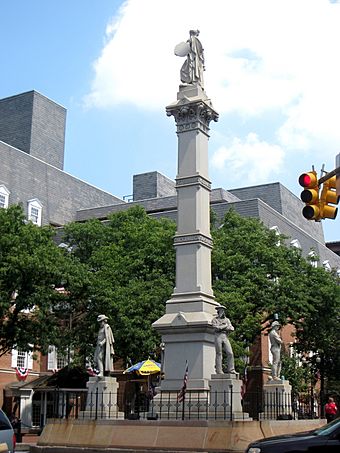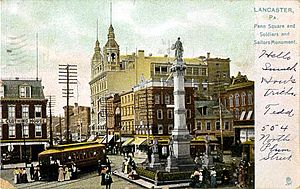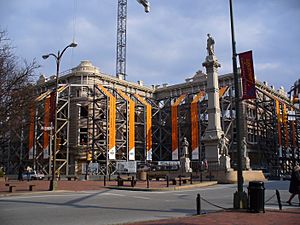Soldiers and Sailors Monument (Lancaster, Pennsylvania) facts for kids
Quick facts for kids |
|
|
Soldiers and Sailors Monument
|
|

The Soldiers and Sailors Monument, looking north up Queen St.
|
|
| Location | Penn Square Lancaster, Pennsylvania, United States |
|---|---|
| Built | July 4, 1874 |
| Architect | Lewis Haldy |
| Architectural style | Gothic Revival |
| NRHP reference No. | 73001635 |
| Added to NRHP | April 2, 1973 |
The Soldiers and Sailors Monument is a tall memorial in Lancaster, Pennsylvania. It stands 43 feet (about 13 meters) high. The monument is built in the Gothic Revival style. This means it looks like old European churches. You can find it in Penn Square, right in the center of downtown Lancaster.
The monument was officially opened on July 4, 1874. It was first built to honor soldiers from Lancaster who died in the American Civil War. These soldiers fought for the Union side. Today, the monument also honors all Americans who have served in other wars.
This spot is very historic. In 1744, the Treaty of Lancaster was signed here. This was an important agreement between the British and the Iroquois people. Later, during the American Revolutionary War, the Second Continental Congress met here. This happened on September 27, 1777. The old Lancaster courthouse stood on this site back then. It was built in 1739.
The Soldiers and Sailors Monument has been a special historic place since April 2, 1973. It is listed on the National Register of Historic Places.
What the Monument Looks Like
The Lancaster Soldiers and Sailors Monument is a 43-foot (13-meter) tall pillar. It is made of strong granite. On top of the pillar is a statue of a woman. She is called the "Genius of Liberty." She wears a robe and a crown of stars. She holds a sword and a shield.
The Genius of Liberty faces north. People say this is so she turns her back on the former Confederate states. These states lost the Civil War.
Around the bottom of the granite pillar are four statues of men. Each man represents a different part of the American military. These are the United States Navy, the United States Army, the Artillery, and the Cavalry.
The monument also has names of Civil War battles carved into it. This is because it first honored those who died in that war. Some of the battles listed are Battle of Antietam, Battle of Chickamauga, and Battle of Gettysburg. Other battles include Battle of Malvern Hill, the Battle of Petersburg, and the Battle of the Wilderness.
Over time, more bronze plaques have been added. These plaques honor service members from other wars. One plaque specifically remembers African Americans who served. Other plaques honor those who died in World War I, World War II, the Korean War, the Vietnam War, and the Persian Gulf War.
The base of the monument has a special message carved into it. It says the monument was built by the people of Lancaster County. It honors their fellow citizens who died defending the Union in the War of the Rebellion (1861–1865).
History of the Monument
The idea for this monument started soon after the Civil War ended in 1865. A group of women called the Patriot Daughters of Lancaster led the effort. Their leader was Rosina Hubley. They wanted to build a memorial for the Union soldiers from Lancaster.
In December 1867, the Patriot Daughters held a fundraising fair. It took place at the Fulton Hall, now called the Fulton Opera House. They raised about $3,500. Their goal was $20,000. The rest of the money came from taxes, county funds, or private gifts. The monument cost about $26,000 in total.
The monument was built in Centre Square, which is now Penn Square. Its construction officially began on November 4, 1872. The monument was unveiled and dedicated on July 4, 1874. At that time, the area had dirt streets and a wooden fence around it.
President Ulysses S. Grant could not attend the ceremony. Many people came to watch. Civil War veterans were there, along with girls from the Mount Joy Soldiers Orphan Home. The monument was dedicated at 1:00 pm. The girls from the orphanage sang a song called My Father's Grave. An American flag covered the "Genius of Liberty" statue.
Rosina Hubley, who worked hard for the monument, spoke on dedication day. She said she hoped it would remind people that "there is something higher and better than self."
In 1877, an iron fence and granite wall were added. These replaced the first wooden fence. The monument was cleaned in 1905 and 1924. On June 8, 1931, a plaque with the Gettysburg Address and a picture of Abraham Lincoln was added. New lights were put on the monument in 1956, 1972, and again in the early 2000s.
In the 1950s, some people wanted to move the monument. They thought it would help with traffic congestion in downtown Lancaster. But the idea was dropped, and the monument stayed in its original spot.
Until the 1970s, cars drove around all four sides of the monument. In 1972, a new traffic plan for Penn Square was made. A brick plaza was built, closing off traffic on one side. This made the area safer for pedestrians. The monument's base was also made smaller. It went from 35 feet (10.7 meters) to 17 feet (5.2 meters). The old iron railing was removed. New granite curbs were added to protect the monument from cars.
Today, the new Lancaster County Convention Center and a Marriott Hotel are across the street. They opened in 2009. The historic Lancaster Central Market, built in 1889, is also nearby. The W. W. Griest Building is close by too.
Images for kids
See also
 In Spanish: Monumento conmemorativo a los soldados y marineros (Lancaster) para niños
In Spanish: Monumento conmemorativo a los soldados y marineros (Lancaster) para niños









